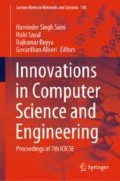Abstract
Web usage mining is used to analyse the user/customer behaviour which is required for business intelligence (BI). The usage of e-payment applications through electronic devices has become more important in organisations and is growing with unprecedented pace. Discovering web usage patterns can result in making strategic decisions for business growth. Especially organisations that need ground truth for exploiting/influencing the customer behaviour. Many researchers contributed towards web usage mining. However, working on real-world data sets provides more useful outcomes. Based on this, we proposed a framework with an EPUD algorithm to perform web usage mining. We have collected electronic payment indicators from RBI dataset and converted it into synthesised server logs suitable for web usage mining. Our algorithm mines the server logs discovers the electronic payment usage and our experimental results reveal the trends in identifying the behaviour of customers in using e-payment systems. The insights in this paper help in understanding the patterns of electronic payment usage for different payment indicators.
Access this chapter
Tax calculation will be finalised at checkout
Purchases are for personal use only
References
Santhosh Kumar B, Rukmani KV (2010) Implementation of web usage mining using APRIORI and FP growth algorithms. Int J Adv Netw Appl 1(6):400–404
Mele I (2013) Web usage mining for enhancing search-result delivery and helping users to find interesting web content. ACM, pp 765–769
Herrouz A, Khentout C (2013) Overview of web content mining tools. Int J Eng Sci 2(6):1–6
Taherizadeh S, Moghadam N (2010) Integrating web content mining into web usage mining for finding patterns and predicting users’ behaviors. Int J Inf Sci Manag 7(1):52–66
Nguyen TTS, Lu HY, Lu J (2014) Web-page recommendation based on web usage and domain knowledge. IEEE Trans Knowl Data Eng 1–14
Mishra R, Choubey A (2012) Discovery of frequent patterns from web log data by using FP-growth algorithm for web usage mining. Int J Adv Res Comput Sci Softw Eng 2(9):1–6
Tyagi NK, Solanki AK, Tyagi S (2010) An algorithmic approach to data preprocessing in web usage mining. Int J Inf Technol Knowl Manag 2(2):279–283
Carmona CJ, Ramírez-Gallego S, Torres F, Bernal E, del Jesus MJ, García S (2012) Web usage mining to improve the design of an e-commerce website. OrOliveSur.com. Elsevier, pp 11243–11249
Jain R, Purohit GN (2011) Page ranking algorithms for web mining. Int J Comput Appl 13(5):22–25
Velásquez JD (2013) Combining eye-tracking technologies with web usage mining for identifying Website Keyobjects. Elsevier, pp 1–10
Mishra MK, Pattanayak BK (2010) Measure of impact of node misbehavior in ad hoc routing, a comparative approach. Int J Comput Sc Issues 7(4):1–58
Munka M, Kapustaa J, Švec P (2012) Data preprocessing evaluation for web log mining: reconstruction of activities of a web visitor. In: International conference on computational science, pp 2273–2280
Romero C, Espejo PG, Zafra A, Romero JR, Ventura S (2010) Web usage mining for predicting final marks of students that use Moodle courses. Comput Appl Eng Educ 135–146
Velásqueza JD, Dujovnea LE, L’Huillier G (2012) Extracting significant website key objects, a semantic web mining approach. Preprint submitted to J Eng Appl Artif Intell 1–23
Shirgave S, Kulkarni P (2013) Semantically enriched web usage mining for predicting user future movements. Int J Web Semant Technol 4(4):59–72
Samizadeh R, Ghelichkhani B (2010) Use of semantic similarity and web usage mining to alleviate the drawbacks of user-based collaborative filtering recommender systems. Int J Ind Eng Prod Res 21(3):137–146
Ramya C, Shreedhara KS, Kavitha G (2011) Preprocessing, a prerequisite for discovering patterns in web usage mining process. In: International conference on communication and electronics information, pp 1–5
Chandrama W, Devale PR, Murumkar R (2014) Data preprocessing method of web usage mining for data cleaning and identifying user navigational pattern. Int J Innov Sci Eng Technol 1(10):73–77
Aldekhail M (2016) Application and significance of web usage mining in the 21st century, a literature review. Int J Comput Theory Eng 8(1):41–47
Singh AP, Jain RC (2014) A survey on different phases of web usage mining for anomaly user behavior investigation. Int J Emerg Trends Technol Comput Sci 3(3):70–75
Rae A, Murdock V (2012) Mining the web for points of interest. ACM, pp 1–11
Bruns A, Moe H (2013) Structural layers of communication on Twitter. In Weller K, Bruns A, Burgess J, Mahrt M, Puschmann C (eds) Twitter and society. Peter Lang, New York, pp 15–28
Radinsky K, Horvitz E (2012) Mining the web to predict future events. ACM, pp 1–10
Singh B, Singh HK (2010) Web data mining research, a survey. In: IEEE international conference on computational intelligence and computing research, pp 661–670
Jiang D, Pei J, Li H (2013) Mining search and browse logs for web search, a survey. ACM 4(4):1–37
Author information
Authors and Affiliations
Editor information
Editors and Affiliations
Rights and permissions
Copyright information
© 2020 Springer Nature Singapore Pte Ltd.
About this chapter
Cite this chapter
Srinivas, K., Rajeshwar, J. (2020). Identifying User’s Interest in Using E-Payment Systems. In: Saini, H., Sayal, R., Buyya, R., Aliseri, G. (eds) Innovations in Computer Science and Engineering. Lecture Notes in Networks and Systems, vol 103. Springer, Singapore. https://doi.org/10.1007/978-981-15-2043-3_40
Download citation
DOI: https://doi.org/10.1007/978-981-15-2043-3_40
Published:
Publisher Name: Springer, Singapore
Print ISBN: 978-981-15-2042-6
Online ISBN: 978-981-15-2043-3
eBook Packages: EngineeringEngineering (R0)

